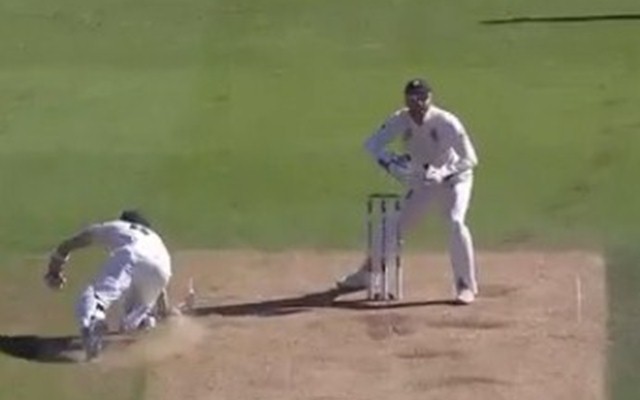Ashes 2019: Why umpires did not penalise England for Jonny Bairstow's fake fielding?
Smith had to dive to reach the crease due to Bairstow's actions.
2 Min Read


The fifth and final Ashes Test is currently in progress at The Oval. Australia have already retained the urn by winning the Manchester Test but are lagging behind in the ongoing encounter. They were bowled out for just 225 runs in response to England’s 294. During the second day’s play though a unique incident hogged the limelight.
It happened during the course of play when Steve Smith set off to take a run from the non-striker’s end. And while he was reaching the crease easily, Jonny Bairstow, England wicket-keeper, acted as if the ball had come into his gloves thereby concerning the batsman of getting run-out. Bairstow just imitated as if he was disturbing the bails with the ball in his hands when the throw had come at the bowler’s end.
Steve Smith, at the same time, dived in a bid to save himself from getting out only to be fooled by Bairstow. While nothing much was said by the players or the Australian team about the incident, Bairstow had clearly violated the fake fielding rule which was introduced by the ICC recently.
Here’s the video
Jonny Bairstow scared steve smith & made him dive to prevent himself from getting runout. Just one problem, bairstow did not even have the ballpic.twitter.com/L3h2wfAVZI
— RaWon (@I2hav_voice) September 14, 2019
What do umpires need to consider?
According to the existing rule, if a player violates the ‘fake fielding’, the umpires are entitled to award five runs to the opposition team. But the on-field officials, Kumar Dharmasena and Marais Erasmus, didn’t feel the need to do so which has left many perplexed. If the player deliberately fakes the fielding, then only the umpires can impose the penalty runs.
Marnus Labuschagne was the first to violate this rule during Australia domestic One-Day tournament when the umpires had penalised his team. Also, Kumar Sangakkara had once bluffed Ahmed Shehzad during an ODI between Sri Lanka and New Zealand.
After the latter incident, Fraser Stewart, MCC’s Laws of Cricket manager, explained the rule stating that it is up to the umpires to decide if the fielder had faked the fielding ‘deliberately’. “The Sangakkara example is less clear-cut. Technically, he is deliberately attempting to deceive the batsman, but I’m not sure what advantage he is gaining – not that the gaining of advantage needs to be proved.
“It seems to be done more out of jest than out of an attempt to cause confusion and prevent a run being scored. Under the letter of the Law, one could not argue with the penalty being imposed. Equally, however, an umpire might choose to handle it by having a quiet word and informing him of the new law. As with any law like this, it is always going to be for the umpires to decide what is “deliberate” and what is “deception”,” he had told while speaking to ESPNCricinfo.
Now if the above explanation is compared with Jonny Bairstow’s incident, the wicketkeeper didn’t gain any advantage as he tried to deceive Steve Smith. Here, it all comes down to the umpires and their judgement. They also have to consider the fact that Smith had to dive to save his wicket due to Bairstow’s actions. While doing so, he could’ve injured himself as well.
Watch – 5 Players who should’ve retired after 2019 World Cup but didn’t
Download Our App